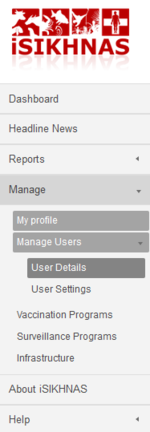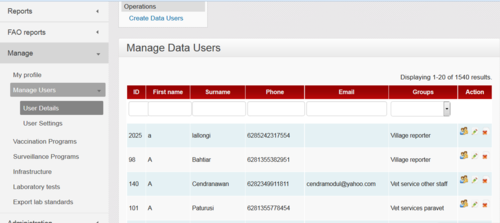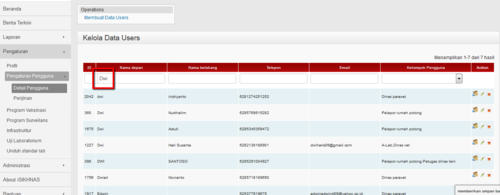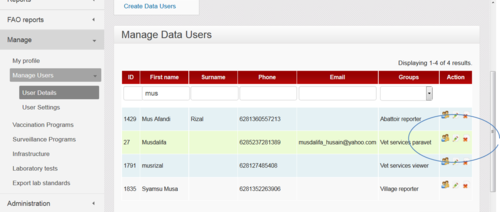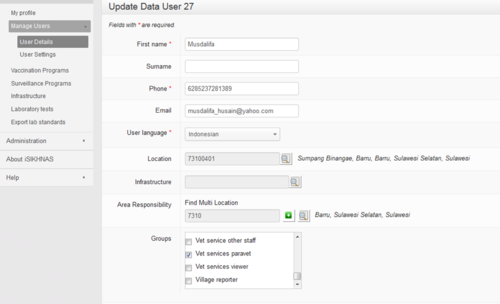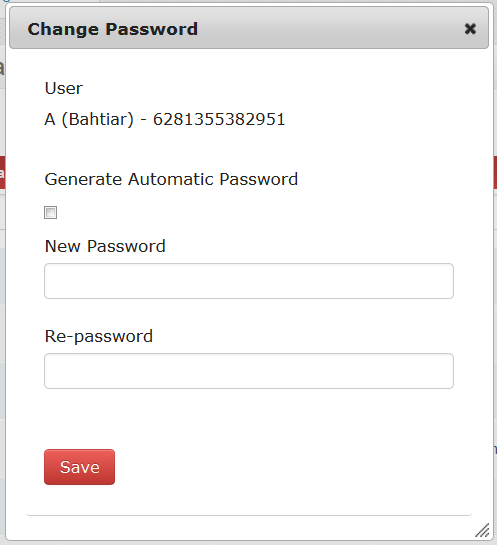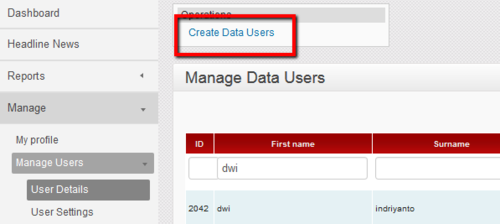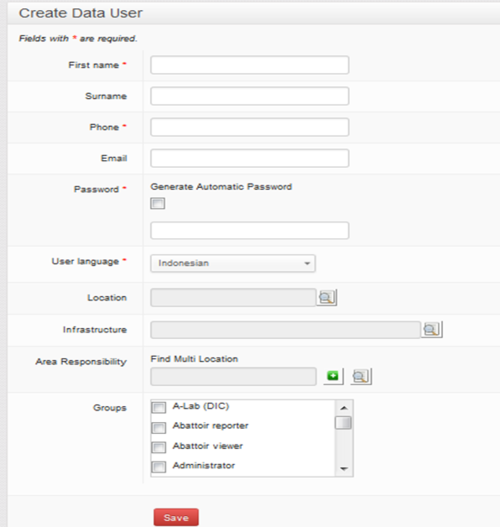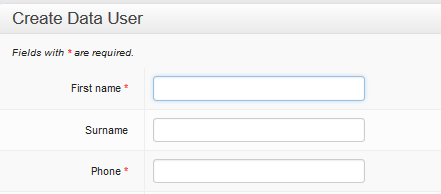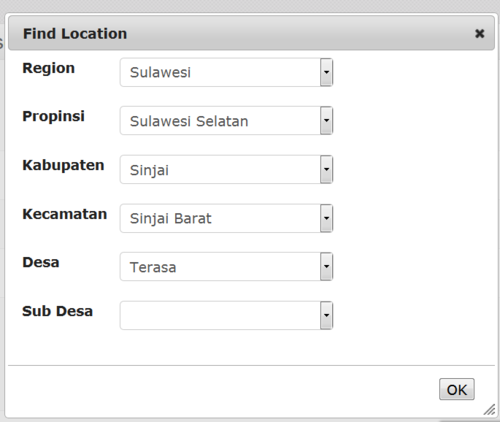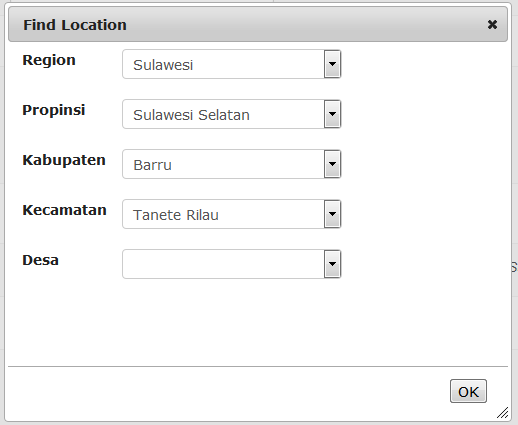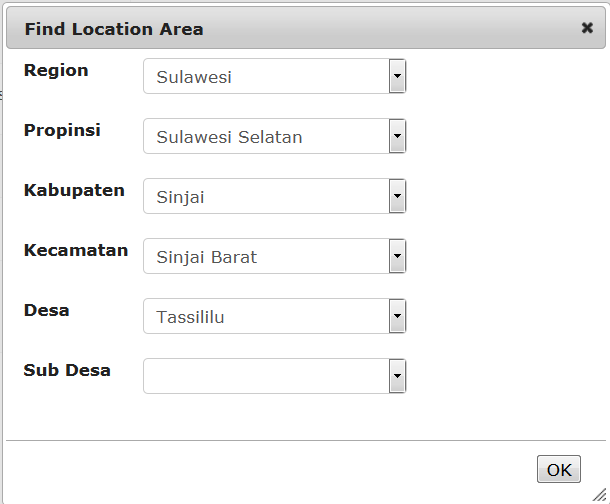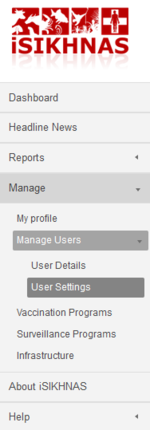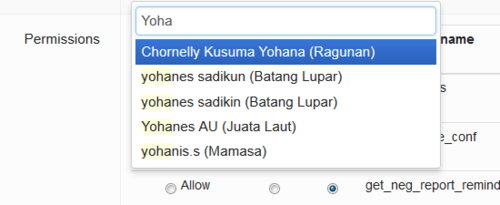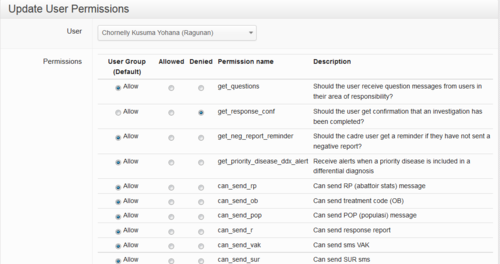Manage : Manage Users/id
Daftar isi
- 1 Pengaturan : Pengaturan Pengguna
- 1.1 Mengubah Data User
- 1.2 Delete Data User
- 1.3 Mengubah Kata Sandi Pengguna
- 1.4 Membuat Data User : Mendaftarkan Pengguna Baru dan Memperbarui Pengguna Terdaftar
- 1.5 First name
- 1.6 Surname
- 1.7 Phone
- 1.8 Email
- 1.9 Password
- 1.10 Location
- 1.11 Infrastructure
- 1.12 Area responsibility
- 1.13 Group
- 1.14 Manage : Manage Users : User Settings
Pengaturan : Pengaturan Pengguna
Salah satu tugas utama koordinator adalah mengelola pengguna sistem. Koordinator kabupaten/kota bertanggung jawab mengelola sebagian besar pelapor data - dokter hewan, paravet, dan pihak lain yang terlibat dalam pengiriman laporan. Salah satu peran penting koordinator adalah memastikan data pengguna selalu diperbarui dan mengelola ijin penggunaan sistem untuk setiap pengguna. Koordinator dapat melakukan hal ini melalui menu Pengaturan : Pengaturan Pengguna : Detail Pengguna pada situs web iSIKHNAS.
Ingatlah bahwa terdapat ribuan pengguna iSIKHNAS sehingga cara paling efisien untuk mencari seorang pengguna tertentu adalah dengan mengetikkan nama pengguna tersebut atau informasi lain yang berkaitan pada kolom kosong di bagian atas laman situs web. Ini akan membantu sistem memilah semua data untuk menemukan pengguna yang dicari.
Langkah ini akan menampilkan sebuah daftar pendek berisi sejumlah pengguna yang dapat anda pilih.
Kemudian anda dapat mengklik ikon di bagian tengah - berbentuk pensil - untuk menyunting data pengguna. Untuk menyunting kata sandi pengguna, klik ikon di sebelah kiri - berbentuk orang dengan kunci. Ikon di sebelah kanan - tanda silang merah - menghapus (atau menyembunyikan) pengguna dari daftar.
Mengubah Data User
Setelah anda memilih seorang pengguna dan mengklik ikon untuk menyunting, anda akan dibawa ke laman situs web untuk memperbarui data pengguna. Ini adalah langkah-langkah yang akan anda lakukan apabila terdapat perubahan data seperti pengguna yang mengganti nomor teleponnya, pindah tempat kerja, memiliki tanggung jawab daerah baru, mulai bekerja di infrastruktur yang telah teridentifikasi, dll.
Jangan lupa untuk mengklik tombol Save (Simpan) di bagian bawah formulir isian setelah anda selesai menyunting.
Delete Data User
It is actually not possible to completely delete data from the database. Data is actually hidden from view when you "delete" it, so it can be retrieved in the future should it ever be necessary. If you need to "delete" a user you can do so by clicking on the cross icon next to the user's name.
Mengubah Kata Sandi Pengguna
Pengguna perlu menghubungi koordinator iSIKHNAS setempat apabila tidak dapat mengingat kata sandi untuk mengakses situs web. Koordinator kemudian harus mengakses data pengguna yang bersangkutan melalui menu Pengaturan : Pengaturan Pengguna : Detail Pengguna : Pengaturan Data User. Cari dan pilih pengguna yang sesuai dengan menggunakan kolom pencarian di bagian atas laman situs web dan klik ikon Change password (Ganti kata sandi). Kemudian anda perlu memberikan kata sandi baru bagi pengguna tersebut. Ini dapat dilakukan dengan membuat kata sandi baru secara otomatis atau sesuai dengan pilihan pengguna yang bersangkutan. Anda melakukan langkah ini dengan cara yang sama seperti pada saat pendaftaran pengguna.
Pastikan anda telah menyimpan kata sandi yang baru dan menyampaikannya kepada pengguna yang membutuhkan.
Membuat Data User : Mendaftarkan Pengguna Baru dan Memperbarui Pengguna Terdaftar
Semua pengguna harus sudah terdaftar sebelum dapat menggunakan sistem iSIKHNAS. Ini berlaku untuk pelapor maupun pengguna data.
Pengguna baru dapat didaftarkan dengan dua cara berikut ini:
- Oleh petugas yang berwenang di lapangan dengan menggunakan telepon genggamnya, atau
- Oleh staf yang berwenang, umumnya koordinator iSIKHNAS kabupaten/kota, melalui situs web iSIKHNAS.
Pendaftaran melalui situs web iSIKHNAS
Pada menu utama iSIKHNAS, buka bagian Pengaturan : Pengaturan Pengguna : Detail Pengguna.
Kemudian klik Create Data User (Membuat Data User).
You will be taken to a new Create Data User form.
Click your mouse in the First name field. The outline colour will change to blue to show that it is active.
First name
Enter the first name of the new user. Try to use correct capitalisation for these name fields. Remember the user name will appear in multiple reports and other areas of the website. Please make sure it is correctly spelled and as complete as possible.
Surname
Move to the Surname field by either pressing ![]() or by using your mouse to take you to the new field and clicking in the empty box. This field is only required for those people who use family names. Leave the field empty if there is no surname.
or by using your mouse to take you to the new field and clicking in the empty box. This field is only required for those people who use family names. Leave the field empty if there is no surname.
Phone
Next, enter the mobile phone number of the new user. This telephone number must be to the unique to the user. It must be the number to phone they use every day for their work. This telephone number will identify the new user to the system every time they report or query data.
Enter an email address if the person uses email. The address should be unique to the new user. It cannot be a group email address, or one that is used by other iSIKHNAS users. By adding an email address, a new user can arrange to have regular reports using iSIKHNAS data, sent by email. The email address can always be added or changed later.
Password
The web password will be useful if users want to visit the iSIKHNAS website to
- Look up data on the site.
- Change a password.
- Change some user details.
You can click the checkbox Generate Automatic Password to ask the system to make a unique password for the new user. Write the password on a piece of paper and give it to the new user.
Passwords can be changed later by the user. Coordinators can also change passwords for users who have forgotten their password. You can either use a password chosen by the new user by writing the password into the empty field.
A word about passwords: Passwords should not contain personal information, whole words or well known characters or names. The best password are longer than 8 characters and created by coming up with an entire phrase that’s easy for the user to remember. Use the first letter, number or symbol from each word in the phrase, keeping punctuation intact as well.
So, let’s take this, for example: Hi! I’m Dhony. I’m from Sulawesi and I like the number 3! Use the first letter of each part and some of the punctuation, and the password could become: H!ImDImfSul&Iltn3! That’s a good, strong, long password that’ll be hard to crack and easy to remember.
Location
Choose the location of the usual place of work of the new user to the village (desa) level. Go through each level to pick from the drop down lists.
When you have finished click OK.
The full location code and name will appear on the form.
Infrastructure
New users can be assigned to infrastructure where they work. The main infrastructure types are
- Abattoirs
- Aggregation points
- Laboratories
- Semen collection points
- Markets
- Veterinary services offices
- Checkpoints
New infrastructure can be created by coordinators using the Manage : Infrastructure
Area responsibility
As well as being assigned to a particular working location - where a user is phyically based most of the time - users are assigned to one or more areas of responsibility. This defines the whole area the user works or is responsible for. This will tell iSIKHNAS that this person should receive alerts or information relevant to that area. It helps to filter the data for the user, to make sure only the most relevant data or alerts are sent.
A regional coordinator for Sulawesi, for example, would be assigned as follows
The provincial coordinator for Sulawesi Seletan would be assigned like this
A dinas paravet in Barru, Sulawesi Seletan might be assigned like this
And so on
A village reporter (Pelsa) would be assigned as follows
A pelsa with two desa under her responsibility might look something like this
Group
Each user is given a User type and is part of a User Group. Some users are assigned to more than one group. This determines what the person is permitted to do, what data they are permitted to submit and view, and what functions they may perform on the iSIKHNAS website.
Users can be assigned to several user types depending on their roles. Click here for more detailed descriptions of user types.
English
| Code | User Type |
|---|---|
| 1 | Champion |
| 2 | Regional coordinator |
| 3 | Provincial coordinator |
| 4 | District coordinator |
| 5 | Vet Services Vet |
| 6 | Vet services paravet |
| 7 | Vet service other staff |
| 8 | Contract Worker |
| 9 | Village reporter |
| 10 | Farmer |
| 11 | Abattoir reporter |
| 12 | Meat inspector |
| 13 | Drug inspector |
| 14 | Check point officer |
| 15 | Quarantine |
| 16 | Public health |
| 17 | A-Lab (DIC) |
| 18 | B-Lab (provincial) |
| 19 | Inseminator |
| 20 | Trainer/demonstrator |
| 21 | Vet services viewer |
| 22 | Quarantine viewer |
| 23 | Public health viewer |
| 24 | Abattoir viewer |
| 25 | Administrator |
| 26 | Provincial Kesmavet Coordinator |
| 27 | National Production Coordinator |
| 28 | Production Provincial Coordinator |
| 29 | Reporting Farmer |
| 30 | Epi Viewer |
| 31 | Project Viewer |
| 32 | Semen collection centre officer |
| 33 | District Production Coordinator |
| 34 | Public Vet |
| 35 | Kader Vaksinator |
| 36 | Head of district livestock and animal health office division |
| 37 | Head of provincial animal health division |
| 38 | Head of dinas vaccination team |
| 39 | data encoder |
| 40 | Head of field vaccination team |
| 68 | C lab |
| 69 | SMS Admin |
| 70 | Survei team |
| 71 | Pregnancy Test Officer |
| 72 | Manager SPR |
| 73 | Tim Upsus Siwab |
| 74 | Superuser |
| 75 | Update locations Officer |
| 76 | Recorder Siwab |
| 77 | champion 1 |
| 78 | champion 2 |
| 79 | Technical Reproduction Assistant |
| 80 | AMPM reporter |
| 81 | Wastukan |
| 82 | Vet Author |
| 83 | Vet Authority Province Level |
| 84 | Sensus Reporting |
| 85 | Logistik Admin |
| 86 | Qurban Inspector |
| 87 | animal traders |
| 88 | API user |
| 89 | Academics |
| 90 | Pelapor Cold Storage |
| 91 | Head of Provincial Services |
| 92 | Head of District Services |
| 93 | Head of Animal Health/Public Veterinary Section |
| 94 | Director of Animal Health |
| 95 | Director of Veterinary Public Health |
| 96 | Kepala Seksi Keswan/Kesmavet Provinsi |
| 97 | Private Abbatoir reporter |
| 98 | Chief Veterinary Officer |
| 99 | Vet Authority Animal Health |
| 100 | Vet Authority Veterunary Public Health |
| 101 | Vet Authority Animal Quarantine |
| 102 | Vet Authority District Level |
| 103 | Head of Technical Unit |
| 104 | Babinsa & Babinkamtibmas |
| 105 | Babinsa atau Babinkamtibmas |
| 106 | Breeding officer |
| 107 | veterinary center staff |
| 108 | Public Reporter |
| 109 | Compartement Reporter |
| 110 | Vets Compartment |
| 111 | Compartement Champion |
Manage : Manage Users : User Settings
Update User Permissions
This part of the website allows coordinators to set the permissions differently for each individual user according to their abilities, training or responsibilities. The example below shows the way the page is organised. The name of the user is identified at the top of the page. You can start typing the name and a drop down list of the closest options will appear.
The list of default permissions will differ according to the User Type the person has been assigned. Coordinators and vets will have a long list of permissions which are possible to change. Other users, such as pelsa, will have very few.
Individual user permissions can be changed from the default settings by clicking on or off the Allowed and Denied buttons.

